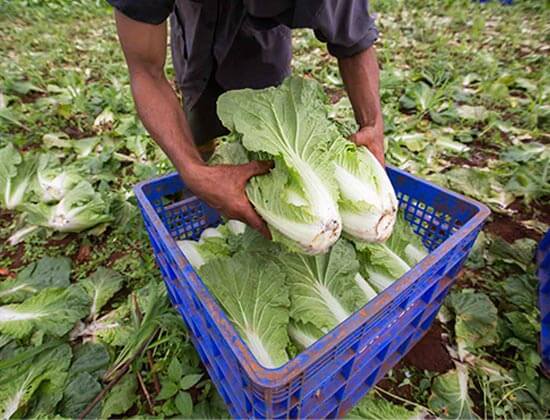Seasonal Agricultural Workers Facts & Stats
Fruits, vegetables and migrant workers in Ontario

Quick facts about fruit and vegetable production in Ontario
- Infographics
- 3,500 fruit and vegetable farmers
- Nearly 100,000 jobs on farm and along the fruit and vegetable value chain
- Over $4.2 billion in annual economic activity in Ontario
- More than 125 different crops grown in fields, orchards and greenhouses across the province:
- These include many long-time favourites from apples, peaches, pears, blueberries, strawberries and grapes to carrots, peppers, onions, lettuce, potatoes, asparagus, cabbage, cucumbers and tomatoes.
- Ontario farmers also grow ginseng, cranberries, garlic, cauliflower, cherries, apricots, hazelnuts, haskap berries and many more crops
- Ontario is Canada’s vegetable king: home to almost 70% of Canada’s production of greenhouse vegetables and the national leader in the production of field vegetables (those grown outdoors instead of in greenhouses).
- Ontario has the most vegetable greenhouses in Canada, covering almost 4,000 acres - or about 10,000 Canadian hockey rinks.
- Ontario is Canada's largest apple-producing province, growing about 35% of the country's apples.
- Through research and innovation, plant breeders are constantly developing new fruit and vegetable varieties that will grow well in the Canadian climate. Here are some examples:
- Radiance, a new sweet potato variety that is ready for harvest sooner and can tolerate cooler temperatures than varieties from the United States
- Cold Snap, a winter-hardy and tasty new pear variety developed by Agriculture and Agri-Food Canada breeders
- More flavourful greenhouse tomatoes designed for specifically for Ontario growers and consumers
Migrant workers in Ontario’s fruit and vegetable industry:
Why they are here and other details while in Canada
Fruit and vegetable farming is very labour-intensive. That’s because many crops bruise or damage easily, so they need to be planted, harvested and cared for by hand. Fruits and vegetables also have very specific and often short planting or harvesting seasons, so often a lot of work has to be done very quickly.
Spring work includes pruning fruit trees and planting crops and although these may sound like easy jobs, they require skill and expertise to be done correctly. If workers aren’t in the orchards, vineyards and fields at the beginning of the season to help with spring work, there will be a much smaller crop to harvest later in the season - or maybe even no crop at all.
Where possible, farmers always prefer to hire Canadian employees first, even in a normal season, there is a significant gap in terms of the availability of local help. In fact, on-farm jobs in agriculture have one of the highest vacancy rates of any industry in Canada, at 5.4%.
Canadian farmers who can’t find enough local or domestic employees rely on workers from other countries to work on their farms. Those workers come to Canada legally under the umbrella of programs like the Seasonal Agricultural Worker Program (SAWP) or under the agricultural stream of Canada's Temporary Foreign Worker Program (TFWP). Over 40,000 workers come to Canada each year in this way to work on fruit and vegetable farms.
Workers under those programs have the same rights and privileges as Canadian workers do, and their employers have the same obligations and responsibilities to those workers as they do for their Canadian employees. Anything else is unacceptable and not condoned by our sector.
The SAWP began in Canada in 1966 when 264 Jamaican workers arrived in Ontario to help with apple harvest. Today, the government-approved program is open to workers from Mexico, Jamaica, Trinidad & Tobago, Barbados and the Eastern Caribbean Islands, who come to Canada to work for a defined period of time before going home for the winter.
With the money they earn in Canada, they support their families and communities back home. There are many examples of workers who’ve been able to establish farms and businesses in their home countries, create local jobs and send their children to university.
The majority of migrant workers come to Canada through SAWP and many have been coming to work on Canadian farms for decades. It is common for many to return to the same farm year after year, where their experience and skills make them valued members of the farming business. On some farms, long-time workers are now joined in Canada by their adult children who are also coming here to work.
Simply put, if Canada’s horticulture sector didn’t have access to this essential migrant workforce, many popular but labour-intensive fresh, canned and frozen fruit and vegetable crops could no longer be grown here, and Canadians would have to rely on farmers in other countries to supply them with their fruits and vegetables.
Canada is not alone among countries who welcome international guest workers to work on farms. The United States, Australia and many European countries, for example, depend on seasonal or migrant workers to plant, manage and harvest fruit and vegetable crops.
Economic impact of migrant workers in Canada and in their home countries
The money migrant workers earn while the are in Canada helps bolster the local economies of their home countries and lift them and their families out of poverty. Employment opportunities in their home countries can be scarce and lacking in job security, and often they can earn more money working on Canadian farms than at home. Their Canadian income helps them support their families, and provide better access to health care and education.



